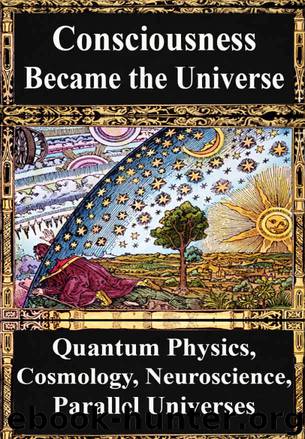How Consciousness Became the Universe: by Chopra Deepak & Penrose Roger & Carter Brandon & Stapp Henry P. & Hameroff Stuart & Dobyns York H. & Kafatos Menas & Mensky Michael B. & Globus Gordon & Kak Subhash

Author:Chopra, Deepak & Penrose, Roger & Carter, Brandon & Stapp, Henry P. & Hameroff, Stuart & Dobyns, York H. & Kafatos, Menas & Mensky, Michael B. & Globus, Gordon & Kak, Subhash
Language: eng
Format: epub
Published: 2015-10-23T16:00:00+00:00
REFERENCES
Addis, D. R., Wong, A. T., & Schacter, D. L. (2007). Remembering the past and imagining the future: Common and distinct neural substrates during event construction and elaboration. Neuropsychologia, 45(7), 1363–1377. doi:10.1016/j.neuropsychologia.2006.10.016
Atance, C. M., & Jackson, L. K. (2009). The development and coherence of future-oriented behaviors during the preschool years. Journal of Experimental Child Psychology, 102(4), 379–391.
Atance, C. M., & O’Neill (2005). The emergence of episodic future thinking in humans. Learning and Motivation, 36(2), 126–144.
Berntsen, D., & Bohn, A. (2010). Remembering and forecasting: The relation between autobiographical memory and episodic future thinking. Memory & Cognition, 38(3), 265– 278. doi:10.3758/MC.38.3.265
Bronckart, J. (2005). The temporality of discourses: A contribution to the reshaping of human actions. In A. Perret-Clermont (Ed.) Thinking time: A multidisciplinary approach. Cambridge, MA: Hogrefe & Huber.
Buckner, R. L., & Carroll, D. C. (2007). Self-projection and the brain. Trends in Cognitive Sciences, 11(2), 49–57. doi:10.1016/j.tics.2006.11.004
Cabanac, M., Cabanac, R., & Hammel, H. T. (2011). Consciousness: The fifth influence. Journal of Cosmology, 14. Retrieved from http://journalofcosmology.com/Consciousness127.html
Carver, C. S., Sutton, S. K., & Scheier, M. F. (2000). Action, emotion, and personality: Emerging conceptual integration. Personality and Social Psychology Bulletin, 26(6), 741–751. doi:10.1177/0146167200268008
Corballis, M. C. (2011). The recursive mind: The origins of human language, thought, and civilization. Princeton, NJ: Princeton University Press.
Corballis, M. C. (2013). Mental time travel: A case for evolutionary continuity. Trends in Cognitive Sciences, 17(1), 5–6. doi:10.1016/j.tics.2012.10.009
Costa, P. T., & McCrae, R. R. (1992a). Four ways five factors are basic. Personality and Individual Differences, 13(6), 653–665. doi:10.1016/0191-8869(92)90236-I
Costa, P. T., & McCrae, R. R. (1992b). Normal personality assessment in clinical practice: The NEO Personality Inventory. Psychological Assessment, 4(1), 5–13. doi:10.1037/1040- 3590.4.1.5
D’Argembeau, A., & Van der Linden, M. (2007). Emotional aspects of mental time travel. Behavioral and Brain Sciences, 30(3), 320–321. doi:10.1017/S0140525X07002051
Dewey, J. (1933). How we think. Buffalo, NY: Prometheus Books. (Original work published 1910)
Fink, A., & Neubauer, A. C. (2008). Eysenck meets Martindale: The relationship between extraversion and originality from the neuroscientific perspective. Personality and Individual Differences, 44(1), 299–310. doi:10.1016/j.paid.2007.08.010
Fink, A., Grabner, R. h., Neuper, C., & Neubauer, A. c. (2005). Extraversion and cortical activation during memory performance. International Journal of Psychophysiology, 56(2), 129–141.
Förster, J., & Becker, D. (2012). When curiosity kills no cat—but mediates the relation between distant future thoughts and global processing across sensory modalities. European Journal of Social Psychology, 42(3), 334–341. doi:10.1002/ejsp.1856
Förster, J., Friedman, R. S., & Liberman, N. (2004). Temporal construal effects on abstract and concrete thinking: Consequences for insight and creative cognition. Journal of Personality and Social Psychology, 87(2), 177–189. doi:10.1037/0022-3514.87.2.177
Fortunato, V. J., & Furey, J. T. (2009). The theory of MindTime and the relationships between thinking perspective and the Big Five personality traits. Personality and Individual Differences, 47(4), 241–246.
Fortunato, V. J., & Furey, J. T. (2010). The theory of MindTime: The relationships between thinking perspective and time perspective. Personality and Individual Differences, 48(4), 436–441. doi:10.1016/j.paid.2009.11.015
Fortunato, V. J., & Furey, J. T. (2011). The theory of MindTime: The relationships between Future, Past, and Present thinking and psychological well-being and distress. Personality and Individual Differences, 50(1), 20–24.
Fortunato, V. J.
Download
This site does not store any files on its server. We only index and link to content provided by other sites. Please contact the content providers to delete copyright contents if any and email us, we'll remove relevant links or contents immediately.
| Aeronautics & Astronautics | Astronomy |
| Astrophysics & Space Science | Comets, Meteors & Asteroids |
| Cosmology | Mars |
| Solar System | Star-Gazing |
| Telescopes | UFOs |
Tools of Titans by Timothy Ferriss(8218)
Turbulence by E. J. Noyes(7936)
Secrets of Antigravity Propulsion: Tesla, UFOs, and Classified Aerospace Technology by Ph.D. Paul A. Laviolette(5309)
Astrophysics for People in a Hurry by Neil DeGrasse Tyson(5131)
Room 212 by Kate Stewart(5035)
Design of Trajectory Optimization Approach for Space Maneuver Vehicle Skip Entry Problems by Runqi Chai & Al Savvaris & Antonios Tsourdos & Senchun Chai(5011)
Pale Blue Dot by Carl Sagan(4912)
The David Icke Guide to the Global Conspiracy (and how to end it) by David Icke(4625)
A Journey Through Divination and Astronomy by Publishing Pottermore(4344)
Goodbye Paradise(3727)
Apollo 8 by Jeffrey Kluger(3637)
COSMOS by Carl Sagan(3554)
Losing the Nobel Prize by Brian Keating(3498)
The Five People You Meet in Heaven by Mitch Albom(3475)
How to Read Water: Clues and Patterns from Puddles to the Sea (Natural Navigation) by Tristan Gooley(3406)
Brief Answers to the Big Questions by Stephen Hawking(3369)
How to Read Nature by Tristan Gooley(3249)
The Order of Time by Carlo Rovelli(3145)
A Brief History of Time by Stephen Hawking(2960)
